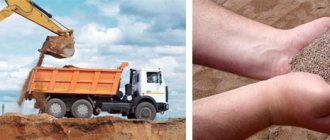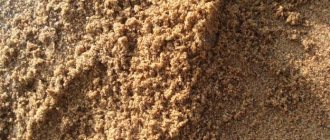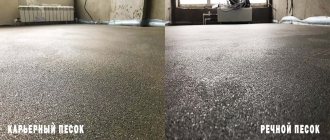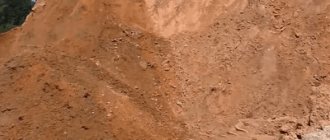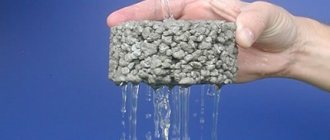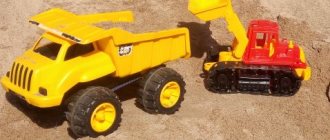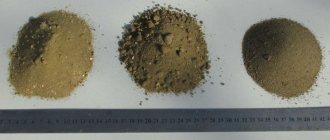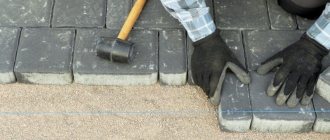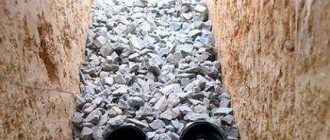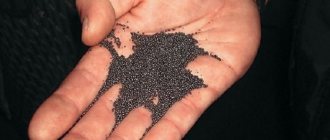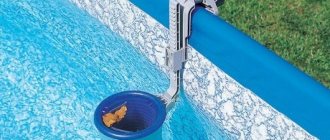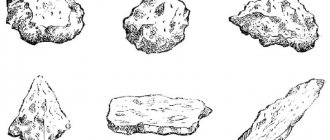Preparing a high-quality concrete mixture is a difficult task, without which no construction project can be completed.
The constituent ingredients of concrete are sand, cement, crushed stone and water. Each of them performs its own specific task, both when creating a concrete structure and when using it subsequently.
When preparing concrete, it is important to adhere to all the rules, use optimally suitable components and not deviate from the desired proportions.
Function of sand in concrete
Before deciding which sand is best to use when preparing concrete, you need to understand what task sand performs for concrete.
In concrete mortar, sand functions as a fine aggregate. It is designed to reduce internal stress during concrete hardening and make the structure more durable.
But the beneficial role of this substance for concrete is noted only when all the necessary requirements for its quality and quantity are met:
- If the volume of added sand is excessive, the resulting concrete will acquire a granular structure that is easy to destroy.
- If the quantity is insufficient, cracks will appear as the solution dries, and depressions may appear on the finished product.
Differences and features of river sand
River sand differs from other types of sand primarily in its natural purity; it does not contain clay particles, small pebbles and other impurities. Its second difference is fractional homogeneity. Dry mixtures for construction work are made from river sand.
It is used as a filler for floor screeds; it is the main component for the production of asphalt concrete. With its help, drainage is installed and used as a filter at treatment plants. Sand perfectly purifies water from mechanical impurities. In household plots, the soil is mixed with river sand to make it lighter and more crumbly.
More details in the video:
Difference from sea
River sand is almost no different from sea sand. Sea sand has high quality characteristics and does not contain natural impurities, since during extraction it undergoes a two-stage enrichment. Therefore, concrete mixtures and solutions are prepared from it.
Difference from career
Which sand is better - quarry or river - depends on the characteristics of the further scope of their application. Quarry sand, as the name implies, is mined in quarries or crushed gravel and other rocks using special devices. It usually contains large amounts of stones and clay.
Quarry sand is easy to extract and is of high quality, but due to the organic impurities it contains, the sand often behaves unpredictably, reacting with chemical additives in the solution. Quarry sand is also not suitable for filtration; washed quarry sand is more often used for concrete.
Types of sand
The composition and parameters of sand largely depend on the place of extraction. When choosing sand, it is important to know that there are river, sea, quartz and quarry sand for concrete.
Features of river sand
River grains have distinctly rounded grains; they are constantly washed by streams of water, making them smooth and polished. This is very important for preparing a high-quality solution, since the particles are distributed evenly and the density of the substance in the concrete can be adjusted.
When thinking about which sand is best for concrete, they often choose the river version, since it does not contain clay and there are almost no stones. Settlement into it is natural and occurs at a high speed, therefore, when using the river type to prepare concrete, it must be mixed all the time. The degree of sand clogging with silt and clay is indicated in the documents for it and cannot be higher than 0.3%.
But we must remember that river material, although not the most expensive, still exceeds the price of quarry material.
When thinking about what kind of sand is needed for concrete, you need to be aware of what is more important to you: the lower price of concrete or its higher strength.
Features of quarry mountain sand
Considering the parameters of quarry sand (mountain and ravine), it is usually used in the production of bricks, screed mixtures, fill for roads and playgrounds. Due to the irregular shape of the grains and clay additives, products using the quarry type are very strong with high internal bonding strength.
If you use the quarry option to prepare concrete, the solution will be of low quality. The grains of sand in it are very small with low plasticity, the substance itself in the solution is distributed unevenly and settles too quickly. The volume of clay additives is slightly reduced in the alluvial form of quarry origin, but it does not occupy an important place in the creation of concrete.
Due to the fact that clay additives and stones can be found in the quarry, it is only suitable for preparing backfill for foundations or concrete screeds.
In the preparation of concrete, the quarry type is also used, but only after it is washed with water, immediately after extraction. This procedure removes clay and dust particles.
Marine and quartz
The properties of sea sand resemble river sand. Its main positive side is the uniformity of its composition. This option can be called the cleanest. Additional cleaning may be necessary due to the large amount of shells expected to be present. Due to constant washing with salty sea water, particles of this type have a regular shape and are all approximately the same size. Marine has the highest cost, since it is mined on the seabed at great depths and requires expensive technology.
Quartz sand is produced by mechanical grinding of rocks containing quartz. This option is clean, chemically inactive, and all its grains are the same size and shape. Extraction is carried out artificially.
How to apply in construction?
Sand in construction
Coarse sand is an absolutely natural, environmentally friendly material. As a rule, it is used for construction - when it is necessary to build a foundation or make concrete. The material extracted from the river is used when paving the road, because it is the basis of the road surface.
Coarse sand, having certain properties, can strengthen the strength of any concrete or reinforced concrete structure. It is also used when it is necessary to lay paving slabs so that there are no puddles left on it. By the way, sand is also needed to make such tiles.
Construction coarse sand is used in the production of concrete or cinder block; it is also necessary in order to make a screed from cement, plaster mortar, arranging a foundation or for finishing work.
For the procedures mentioned just above, you should use exclusively river sand, since it contains no impurities and is an excellent filler for the solution.
Coarse sand is perfect for brick production. In addition, it is applicable for making a solution from which blocks will subsequently be formed. It is thanks to sand that a fairly strong block skeleton is obtained, making it much more resistant to various external influences.
Properties and characteristics of sand
All necessary requirements for the quality of sand used in the preparation of concrete are documented. Some characteristics of this substance can only be studied in a laboratory, but there are some that are checked by eye immediately before construction.
Particle size
To know what kind of sand to use for preparing concrete, you first need to decide on one of the most important parameters of the material – the size of the sand grains. The following types of this substance are distinguished based on the size of its particles:
- consisting of large particles (grains of sand have a size exceeding 3.5 mm);
- increased fineness (sand grain size from 3 to 3.5 mm);
- large (within 2.5-3 mm);
- medium size (2-2.5 mm);
- fine fraction (1.5-2 mm);
- very small (1-1.5 mm);
- thin (0.7-1 mm);
- very thin (up to 0.7 mm).
To find out the size of sand grains, specialists pass the substance through a sieve with the appropriate hole diameter.
In fact, such a division is more conditional, only documented.
In real life, there are 3 types of sand based on particle size: small, medium-sized and with large fractions.
What kind of sand is used when preparing concrete mortar? To make the structure really strong, you need a large type, but it needs to have a lot of small grains of sand in it.
Otherwise, there will be a huge number of voids in the concrete, which can reduce the strength of the finished structure. In addition, the resulting voids can be filled with cement, which equals an increase in the cost of the finished product. It is an irrefutable fact that particles of the same size do not fit tightly together, thus the number of voids is much greater. Based on this, a mixture of sand with different sizes of sand grains is mainly used in order to achieve maximum density between the components of concrete.
Based on the size of sand grains, the substance itself can be divided into 2 classes. In the first class there are no particles whose diameter is below 1.5 mm. This is the optimal material for construction, because the presence of such fine aggregate has a negative effect on the settlement of larger grains of sand. The second class is characterized by the presence of small particles.
Volume weight
This indicator characterizes the weight of 1 m³ of sand in its natural state. Typically, the weight of a cubic meter of this element is approximately 1.5 -1.8 tons. It is desirable that this figure be lower.
Compound
According to its constituent elements, sand is divided into:
- Granulometric (combines the combination of sand grains of different sizes).
- Mineral: quartz, dolomite, feldspathic and limestone.
- Chemical (in accordance with the components present in the composition, the intended scope of application is determined).
Humidity
Typically, this figure is 5%. If the substance is dried, its moisture content will be 1%; if moisture is added in the form of precipitation, it will be 10%. Humidity determines the amount of water that must be added to the concrete mixture.
Immediately before use, you can independently control the moisture level of the sand. If you squeeze it with your palm and it crumbles, therefore the humidity is optimal; if not, then its value is more than 5%. But it is better to check this characteristic in a laboratory.
Porosity coefficient and bulk density
The coefficient characterizes how sand, and then concrete, can resist the passage of moisture. This coefficient is checked only in the laboratory.
On average, the optimal density should be kept at 1.3 - 1.9 t/cub.m. If the indicator is lower, this indicates that the substance contains unnecessary additives; if it is higher, this indicates high humidity. All information must be submitted in the appropriate documentation.
Our company also supplies and sells coarse river sand. Sale of river coarse sandboth in large and small volumes from 10 m3.
Delivery of river sand
is carried out by our own transport, such as KAMAZ, MAZ, VOLVO dump trucks, etc.
We guarantee timely delivery of coarse sand
.
The price for river coarse sand
is from 550 rubles per cubic meter.
All coarse river sand
It is mined in quarries in Moscow and the Moscow region. From time to time we import sand mined in other regions of Russia.
river sand
is a natural material that is extracted using a hydromechanized method from the bottom of rivers.
River sands differ from other types of sand (quarry, construction, quartz...) in that they practically do not contain clay particles, stones and pebbles and other impurities. The size modules are mostly medium. Coarse river
sand is usually less common, so it is more expensive.
It is used for masonry, finishing, design work, for the construction of bases and road surfaces
- this sand is of high quality, but also has a significant cost.
River sand
also used as a filler for heavy, light, fine-grained, cellular and silicate concrete, mortars, preparation of dry mixtures, preparation of various grades of concrete, as well as for drainage.
Of the disadvantages of river sand
Builders believe that river sand in the brickwork mortar “settles” very quickly, and the mortar must be additionally mixed. • Sand size group 1.6-2.8 • Content of silt and clay particles, incl. clay in lumps, 0.3% • Filtration coefficient 5-7 m/day. • Radioactivity class 1 class A eff. 47 BC/kg • Density of water-filled soil, g/cm3 1.65
River sand
intended for use It is used for such construction work as masonry, screed, (less often - plaster) filler for grouts and dyes. In some cases, it is used in the production of reinforced concrete products. In particular, paving slabs. River sand contains minimal clay impurities and has a significantly higher filtration coefficient compared to quarry or unfractionated sand. Quality indicators comply with GOST 8267-93
Coarse river sand
particle size module from 2.5 to 3 mm. Coarse sand is mainly used for the manufacture of concrete products,
Coarse sand
also used in the production of dry mixtures. In the production of paving slabs, coarse sand is also indispensable. It is very important not to make a mistake in choosing the sand that is right for you.
The very name of river sand
speaks of its origin. This sand is mined from the bottom of rivers.
The principle of extracting river sand is similar to the technology of extracting sand in quarries - a dredger attached to a barge pumps sand from the bottom of the river through a pipe and immediately loads it onto another barge. Barges are usually lined up in a row, just like cars in quarries.
By particle size river sand
Available in small, medium and large.
coarse sand
In professional language, the size of sand particles is the fineness modulus.
Sand from 0.6 mm to 1.5 mm is considered fine.
Sand with a grain size from 2.0 to 2.8 g/cm3 is medium-sized sand. Such sand is often used as a filler for heavy, light, fine-grained, cellular and silicate concrete, mortars; used for the preparation of dry mixtures, for the construction of bases and coatings of highways and airfields.
Coarse sand
– this is sand with a particle size modulus of up to 5 mm. This sand is extracted from rocks using special crushing and grinding equipment.
river sand
often used for preparing concrete mixtures and cement, used for installing floor screeds, and for installing drainage. Drainage - A layer of sand at the base of a structure's foundation that serves to drain wastewater so that water does not become retained.
river sand
Due to its natural properties, it perfectly passes water, due to which it serves as a high-quality filter material. Any sand has its own filtration coefficient. Quarry sand has a filtration coefficient of no more than 4 meters per day, which makes it unsuitable for these purposes.
Composed of river sand
contain silt and clay inclusions. Its suitability for various construction works depends on their percentage.
The surface of our planet is made up of clays, sands, sandstones, limestones, etc. and so on. (a huge amount), occurring in the form of layers. This is a layered shell. At depth there are granites and quartzites. There are no rocks that have not changed their appearance at all. Sand was formed during the destruction of granite, gneiss, sandstone or some other rock, sandstone during the cementation of grains of sand, etc. It turns out that all rocks were formed at the expense of other rocks with a change in appearance, often in mineral and chemical composition. Loose rock made from fragments ranging in size from 0.1 to 1 mm is called sand, and cemented rock is called sandstone.
river sand
,
coarse river sand
,
river sand sale
,
river sand delivery
Quantity calculation
In order for the grade of concrete to be high, it is necessary to comply with the requirements for the use of all its components. Often, a ratio of 1:3:5 is used, which means cement, sand and crushed stone, respectively. Water is added little by little in the amount of 50-70% of the total weight of cement. But to prepare high-quality concrete for the construction of high-rise buildings or load-bearing floor slabs, it is extremely important to maintain accurate calculations.
To correctly calculate the proportions of all components, follow these recommendations:
- to prepare concrete grade 100, use sand with grains of sand with a diameter of no more than 2.5 mm in a ratio of 1: 7: 4.6 (cement, crushed stone, sand, respectively);
- for brand 150 – proportions 1:5.7:3.5;
- for 200 - 1:4.8:2.8;
- for 300 – 1:3.7:1.9;
- for grades higher than 400 and 450, sand particles over 3.5 mm are used, the proportions will be 1: 2.7: 1.2 and 1: 2.5: 1.1.
Often, the necessary attention is not paid to the importance of fine sand in concrete mortar. But in vain, since by correctly choosing this element and calculating its weight in the solution, you can reduce the price of concrete (by reducing cement consumption), increase its strength and grade.
To create a high-quality solution, it is optimal to use coarse river sand, but with a considerable number of small particles. It is also planned to add a washed quarry type, which, by using it, can significantly reduce the cost of concrete. But we must not forget that if you overdo it with savings, the strength and stability of concrete products can significantly deviate from high values.
A simple way to check the quality of sand:
To buy high-quality sand, it is not necessary to take it to a laboratory to identify foreign impurities. In a transparent container, say, a quarter of a liter glass jar is filled with sand and a quarter of water is poured, after which it is mixed well with the sand. If after 5-10 minutes the water cannot be said to be relatively transparent, then it is not recommended to use such sand for screeding.
Sand for mortar when used in industrial premises:
To install a semi-dry screed in industrial premises where the base will be subject to significant loads, you need to use only clean and high-quality sand. For such a screed, sifted sea sand of a coarse fraction from 2.5 Mk is perfect. To improve the characteristics, it is also possible to add granite screenings to the solution.
When installing a floor screed in such premises, it is recommended to carry it out with additional reinforcement with a steel frame or reinforce it with a steel road mesh with a rod thickness of at least 4 mm, or use a modern frame made of composite material.
Sand for screeding in residential premises, country houses, offices:
Sand for semi-dry screed in residential premises where there is no significant load on the base, alluvial quarry sand with a fineness modulus of 2.0 to 3.0 Mk is excellent; such sand contains minor inclusions of clay, but they will not affect the strength of the finished screed.
